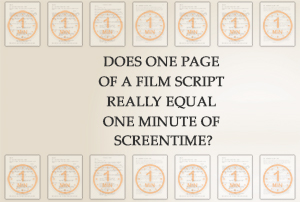 A few weeks ago, John August dropped me an email which included a simple question: “How accurate is the page-per-minute rule of thumb?”
A few weeks ago, John August dropped me an email which included a simple question: “How accurate is the page-per-minute rule of thumb?”
The rule John is referring to is that a film based on a (properly formatted) 90-page screenplay will be roughly 90 minutes long. This is useful to a number of people, including;
- Screenwriters who can estimate how long each scene will be for the audience,
- Directors who can ensure the film unfolds at their desired pace,
- Producers and Studios who can check if the film is within the boundaries of commercial exploitation,
- Actors who can get a sense of their character’s screen time,
- Post-production staff who can estimate how much work they may have to do on the final edit.
This isn’t a comprehensive list but already you can see that many different types of industry people rely on the rule being at least broadly correct.
But is it?
Let’s see what the data reveals…
A quick primer on film screenplay formatting
The formatting on a modern film script is extremely exacting, including pre-defined margins, layout, headings, capitalisation and font (12 point, 10 pitch Courier Typeface). The key elements are:
- Scene heading – Setting out where the upcoming scene takes place and sometimes a time of day/night. INT is used for interior scenes and EXT for exterior scenes.
- Action – Descriptions of what is happening in the scene, how the characters are moving and anything else the reader/viewer needs to know which is not contained in the dialogue.
- Character – The name of the character who is about to speak.
- Dialogue – The words the character is speaking.
- Parentheticals – A few words in brackets between the Character and Dialogue, giving guidance on how the line is to be spoken. Writers are normally advised to keep these to a minimum and only to use them when vital to understanding, such as “(sarcastically)” or “(to the dog)”.
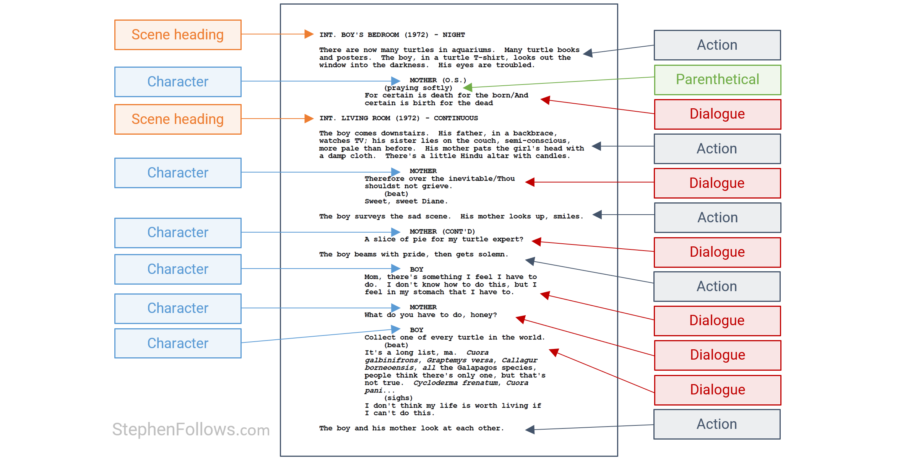
There are other elements and formatting rules but I’m focusing on the ones which affect our investigation of the one-minute-per-page rule. There are plenty of guides online on how to format a screenplay. It’s also worth noting that film scripts are formatted differently to TV, radio and theatre plays.
Searching for a relationship between length and runtime
Given that formating is so rigid, it’s certainly possible that there is a correlation between page count and screen time. Writers do not have much scope to change the length of their Scene headings, Character names and Parentheticals (as counted by lines, not words) and so the elements most that could most affect the length of a script are Action and Dialogue, which also heavily affect the length of a finished film.
For brevity’s sake, I have moved my full methodology to the final section of this article. I built a dataset of 761 scripts which had all been made into theatrically released movies. I removed any cover pages from the total page count and also removed four minutes from the publicly listed running time of a movie (my past research has shown that 3 minutes 43 seconds is the median end crawl length).
To measure the effectiveness of the rule I looked at the ratio of pages to minutes. A 50-page script which becomes a 100-minute movie would have a ratio of 0.5, a 100-script and 100-minute movie would have a ratio of 1 and a 100-page script which created a 50-minute movie would have a ratio of 2.
As you can see below, there is some clustering around a ratio of 1. However, only 22% of scripts had a ratio between 0.95 and 1.05. In fact, only two-thirds were within 0.8 and 1.2, which means that a 100-page-script could have a running time of anywhere between 80 and 120 minutes – a very wide margin.
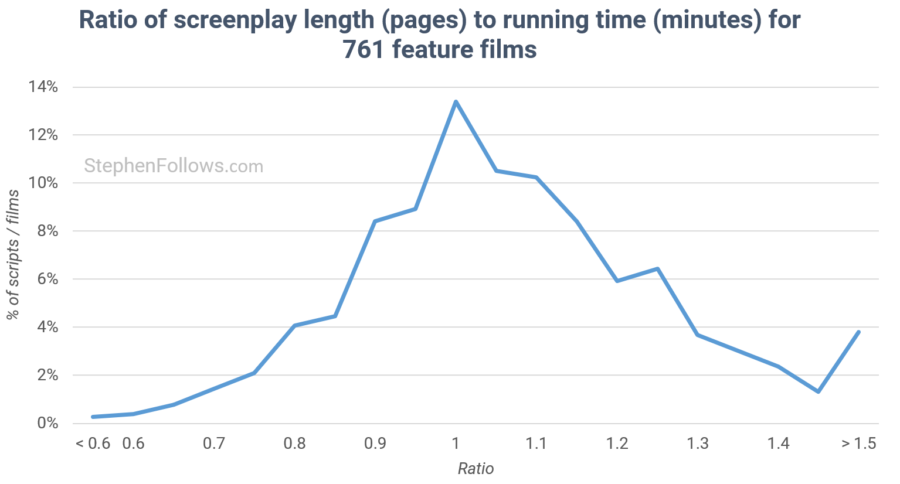
Another way of looking at the data is to plot the length of the scripts and finished movies in a scatter plot.
On the chart below, the orange area shows projects which are within 10% of the rule, on either side. As you can see, most projects fall outside of this.
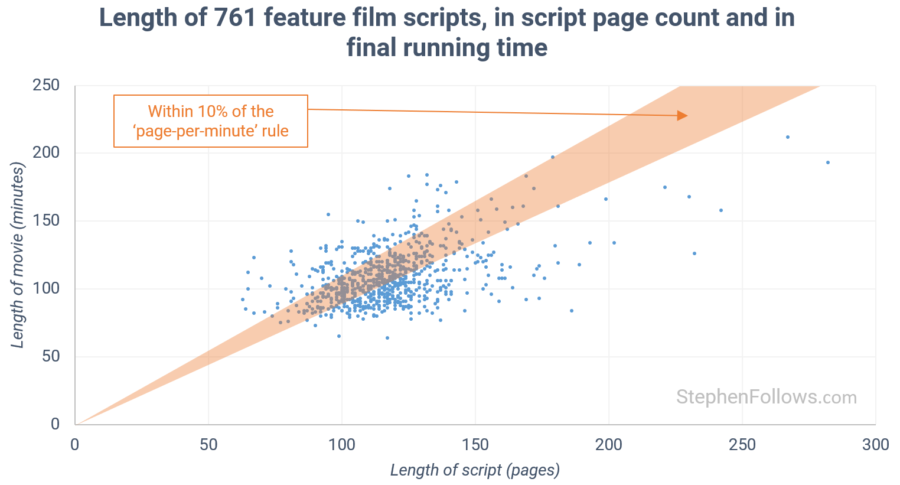
So if you’re in development and holding a script, the page-per-minute rule isn’t much use to accurately predict the length of the finished film.
But the data journey doesn’t end there. While this result may sound neat, there are a few factors we should take into account before completely dismissing the rule. These are:
- Scripts are normally longer than movies
- Not all films contain the same kind of material
- The amorphous nature of Action
Let’s tackle each one briefly…
1. Scripts are normally longer than movies
The average script in the dataset (sans cover pages) was 118 pages while the average running time for those same projects (sans credits) was 109 minutes. So, en mass, we could say that the rule for these scripts is ‘one page per 56 seconds’ or ‘1.08 pages per minute’. In either case, it’s less catchy.
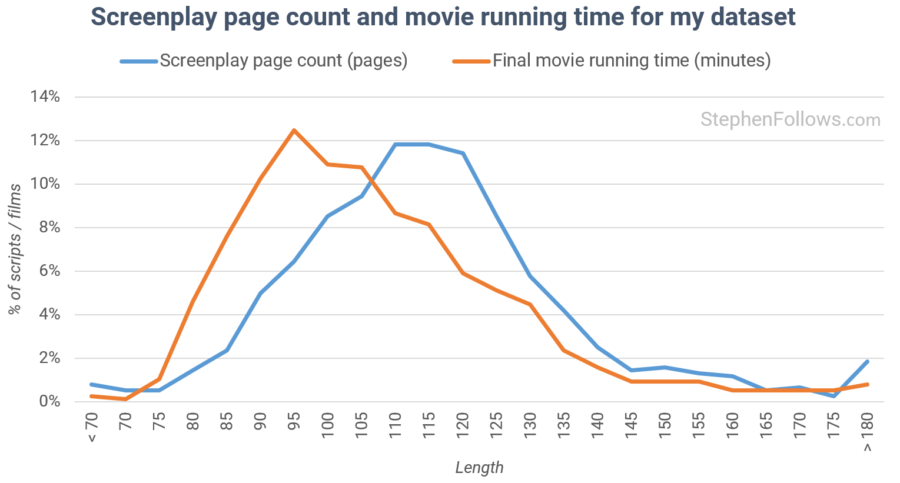
Part of the problem is that the “final” script does not always represent the finished film. A film will go through a number of stages between the first draft and the final movie. The list below is not a strict chronology but more of an example of the many phases that can shape a film’s contents:
- The writer(s) create multiple drafts of the script
- Directors, producers, studios (and sometimes powerful actors) will suggest changes.
- Changes will be made to accommodate the budget, schedule, locations, weather and force majeure.
- The actors and director will work together to craft a performance, sometimes changing the lines.
- The editor will edit the final scenes from what was shot.
- “A final” cut can be affected by the requirements of censors, exhibitors, airlines and broadcasters.
All of this means that the words in a draft of the script may not reflect every part of a finished film. Moreover, all but the first couple of stages are much more likely to reduce the length of the movie than to increase it. That’s because of:
- Budget pressure – During pre-production, shooting and post-production, the pressure is always to save money and so cuts are inevitable. Having an extra page costs next to nothing but having an extra scene to shoot is a real drag to the budget and schedule. Therefore, the closer the production is to the shoot, the greater the scrutiny each element will be under to justify itself.
- Subtraction > addition – It’s much easier for a film to get shorter than longer. Removing a line, moment or scene is as simple as crossing out pages or deleting edit clips, whereas creating new things takes more planning.
- We shouldn’t expect otherwise – As we’ve seen, the page-per-minute rule is often wrong and so has warped our expectations of how long a script should be.
2. Not all films contain the same kind of material
By lumping all 761 scripts into one set of calculations we are ignoring that movies can differ significantly from each other.
Splitting up the dataset by genre can teach us a couple of things. Firstly, all genres show a ratio of above one, meaning that in all cases the average script is longer than the eventual movie. Secondly, there are differences – Adventure and Action films are the closest to the page-per-minute rule, while Comedy and Horror are the furthest from it.
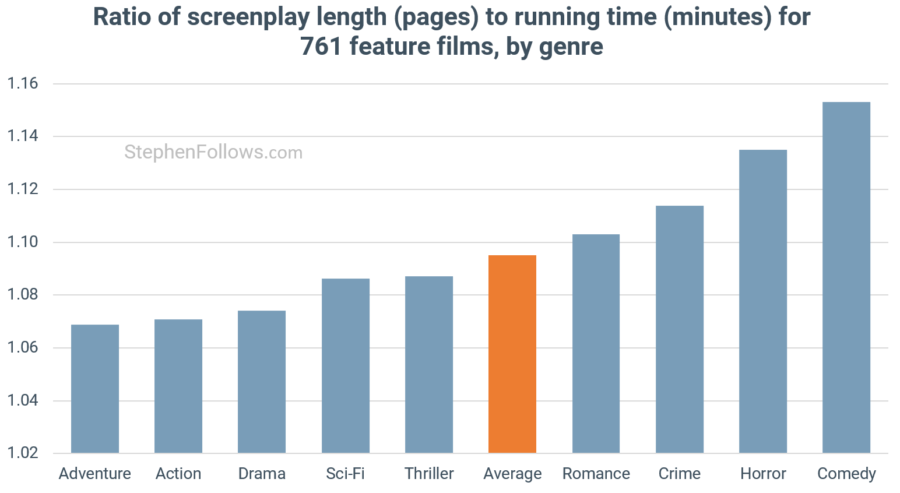
This raises the question of what is different about the contents of movies between genres. After all, in theory, it takes the same amount of page length and screentime to say “I love you” as “Time to die”. In practice, some genres are more likely to contain longer or more frequent lines of dialogue than others.
Last year I conducted a large research project into over 10,000 feature film screenplays submitted to script competitions and to professional script readers. Using that data we can get a sense of how each genre differs.
The chart below shows the percentage of scripts which were taken up by dialogue. There are some similarities to the chart above (i.e. Action and Comedy being on the opposite end of the spectrum) and some differences (i.e. drama and horror place very differently between charts).
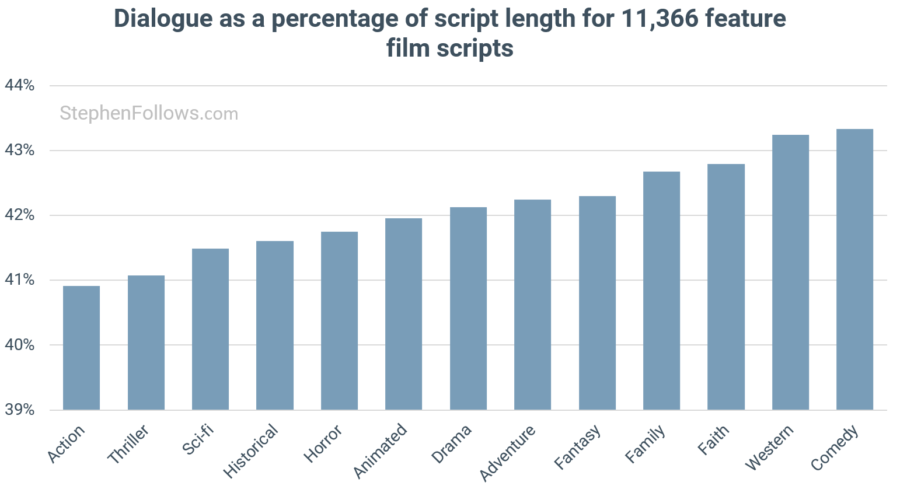
This shows us that there are some differences, but they are not huge. Therefore, perhaps the differences are to found in the Action blocks.
3. The amorphous nature of ‘Action’
Part of the reason any such rule will always be shaky is that the number of words/lines of Action does not denote its screen time. We could imagine one script with a full page of Action describing a location in exquisite detail while another script includes the line “The two massive armies fight to the death”.
I wanted to test the theory that dialogue is fairly consistent (i.e. pages to minutes ratio) but it’s the Action blocks which cause the one-page-per-minute rule to fall apart. To do this, I took 64 scenes which were almost entirely dialogue and looked at their screentime in the finished movie.
The chart below shows what I discovered, namely that pages and minutes were less correlated in these scenes that within the complete dataset of all scripts. I have added an orange line to indicate where one-page-per-minute would be, revealing that two-thirds of the scenes had a ratio of over 1.
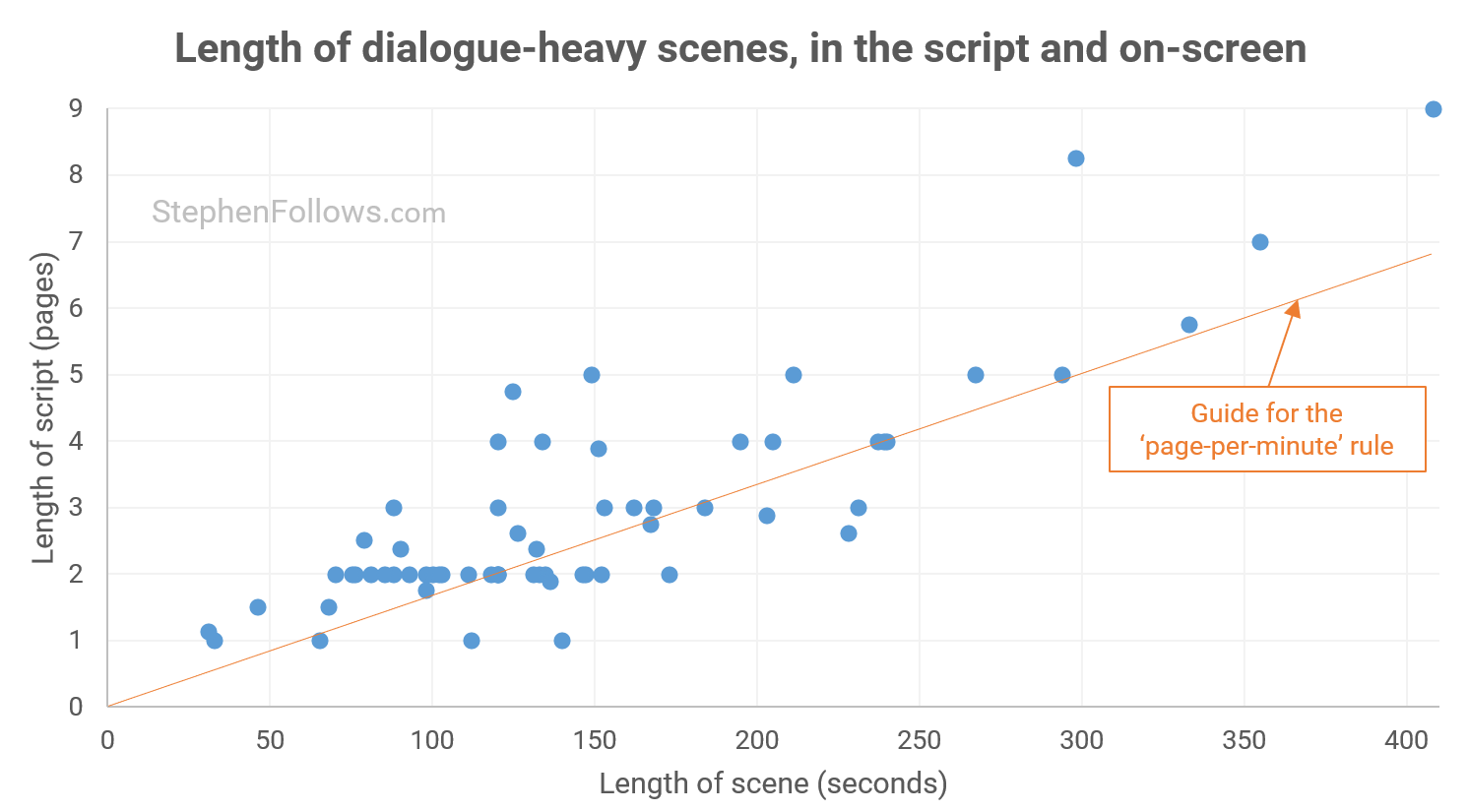
Crucially, the standard deviation (a measure of how different a set of numbers are from each other) among the scenes was 0.41 whereas for all scripts taken together it was just 0.20. This reveals a couple of important things about our rule:
- It’s not just the Action blocks which are causing the variations between scripts. The length of dialogue-only scenes cannot be accurately predicted by script length either.
- The rule does not work on a per-scene basis. If you are going to apply the page-per-minute rule, you should do so across a whole script or, better yet, a collection of scripts, rather than on any one particular scene.
This brings to mind a theory first popularised by Francis Galton and later expanded upon by James Surowiecki in his terrific book ‘The Wisdom of Crowds‘. It states that if a large group of people is trying to guess an answer, it’s often the case that no one gets the answer right but that the average of all guesses is likely to be correct. That’s because some people over-guess, while others under-guess. And that’s what’s happening here, to some extent. Some Action blocks are extremely descriptive, while others are spartan, but overall they more or less average each other out.
Final analysis: Is the page-per-minute rule ever effective?
We’ve seen how shaky the rule is, in mathematical terms at least, but that doesn’t mean that it should be dropped completely.
There are a few things the rule is good for:
- Least-worst rule we have – It does work as a crude guide in many cases. Assuming no one is making major decisions based purely on this rule, then it’s not doing much harm.
- It frames scriptwriting – The rule is easy to remember, and therefore more likely to be used. Seeing as we should always remember that a script is a blueprint for an audio-visual work (as opposed to a piece of stand-alone prose), it may be useful in keeping the nature of screenwriting front of mind during the development process.
- Useful as a non-literal allegory – It speaks to a wider truth, that ‘more pages = more minutes = higher budget’. While the exact prediction of running time may be off, it does allow everyone to quickly see that the average 200-page script is too long and the average 60-page script is too short.
This was never meant to be a scientific rule, just a helpful heuristic. So what do you think? Should we still be using it? Screenwriters – have you found this rule to be useful or does it have negative effects on your work?
A note from John August
 When I sent John the results of my research he asked me to add this note:
When I sent John the results of my research he asked me to add this note:
These findings largely match what I expected: that the page-per-minute rule of thumb mostly stems from the observation that most screenplays are around 120 pages and most movies around 120 minutes long. It’s an estimate that sort of works in aggregate but isn’t very useful for any given project.
Unfortunately, too many folks in the film and television industry have internalized one-page-per-minute as an axiomatic Truth. So any script that is longer than 120 pages is automatically perceived as being too long. Indeed, some studios’ contracts specify that the writer may not deliver a script longer than 120 pages. Screenwriters waste time making tiny edits with the goal of moving page breaks to bring their scripts under this artificial limit. It’s pointless busy work.
Is it appropriate to try to estimate a project’s running time based on the script? Absolutely. Before a project goes into production, the script supervisor — an experienced professional who works beside the director on set — generally performs a “script timing” by estimating the time for each scene. It’s not perfect, but it better reflects reality. If a script times out to three hours, better to know it before production, so you’re not shooting scenes that won’t make it into the film.
Is there an opportunity for computer-generated running time estimates? Probably. With machine learning, I can imagine systems that better predict how words on the page will reflect minutes on screen. But I wonder if it’s a false goal. Ultimately, running time is a factor of film editing. Scenes get dropped in post, and it’s very hard to anticipate these changes when looking at a script in preproduction.
This analysis was done on feature films, but every TV show faces similar issues. However, long-running shows have the advantage of knowing how their specific show works. My hunch is that every NCIS script falls in a narrow range of scenes and pages because they know what they need.
Thank you Stephen for accepting this challenge and myth-busting this rule of thumb.
— John
Further reading
If you are interested in reading more data-led analysis of screenwriting topics then you may enjoy the following articles:
- Defining the average screenplay, via data on 12,000+ scripts
- An analysis of 12,309 feature film script reports
- Who dominates the screenwriting software market?
- What percentage of screenwriters write a second movie?
- What percentage of directors are writer-directors?
- How old are Hollywood screenwriters?
Notes
This project wouldn’t have been possible without the hard work of Liora Michlin. Thank you to John August for the question and for his notes during the process.
My methodology was that I started the research by collecting as many scripts of produced films as I could. I ended up with over 1,500 PDF screenplays from a variety of sources including ones I already had, leaked scripts, those published by writers and those published by studios during awards season. I was surprised at just how many scripts available online were incorrectly formatted. Some were clearly wrong (i.e plain text or the wrong font) while others had subtle differences (i.e. incorrectly spaced). After narrowing the scripts down to just those which fully match the formatting guidelines, we had 761 PDF screenplays (in US letter format)
I sought out finished scripts, not transcripts. A film script includes all the elements we spoke about before and this is what the rule we’re testing applies to. By contrast, a transcript is often just a list of the lines of dialogue spoken, written down from the finished film. A transcript is vital for certain post-completion activities, such as subtitling, translations and accessibility, but it is not a film script and is not what screenwriters are hired to create.
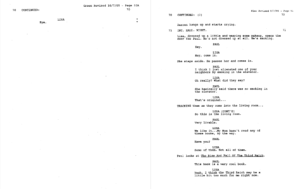 My aim was to find the final draft written by the screenwriters. I rejected scripts which had been adapted during the production process. Once a script enters pre-production it is “locked” and scene/page numbers are added. If script edits are made after this period, the original numbers will be maintained and new scenes/ pages will be markered by letters (i.e. a new page between pages 5 and 6 will be 5A). This helps the production teams stay in sync with the numbering, but completely ruins the idea that any such page-per-minute rule could apply. Some new pages will have just one line, with the rest of the sheet being blank.
My aim was to find the final draft written by the screenwriters. I rejected scripts which had been adapted during the production process. Once a script enters pre-production it is “locked” and scene/page numbers are added. If script edits are made after this period, the original numbers will be maintained and new scenes/ pages will be markered by letters (i.e. a new page between pages 5 and 6 will be 5A). This helps the production teams stay in sync with the numbering, but completely ruins the idea that any such page-per-minute rule could apply. Some new pages will have just one line, with the rest of the sheet being blank.
For the per-scene research, we used subtitles from YIFY Subtitles to check if (a) each line of dialogue was in the final film; and (b) the exact running time of the scene.
It’s worth noting that writing style will also play a part in length. This is not something I can quantify with data so I left it out of the main piece. Prior to doing this research, I thought that this would be the major source of differences between scripts. However, having read many scripts for this research I am left feeling that there is far less variance between writers than I first thought (with regard to pages-per-minute).
Epilogue
This was a fun project to do. When John emailed to ask, I was instantly keen to start and annoyed I hadn’t thought of this already! It’s a rule I had long followed and repeated but not once thought to check.
If you have any industry rules, adages or old wives tales you want tested, drop me a line and I’ll go all data-ninja on their asses…





Comments
Thanks Stephen – really interesting insights and answers to a question I have often mulled over. Found the ratio/relationship of genre to dialogue percentage interesting (even if only across a 4-5 percent differential). Have just shared it with the writer group I host on FB. Cheers
Bob
Worth bearing in mind too that the rule is based on US Letter paper (as you note). Most of the world works with A4, and the same script will have 5-10% fewer pages on A4 than on US paper, which is fatter but shorter. Even if you convert it to the official formatting to do a final count, chances are most writers outside North America will have their software set to the paper in their printer while they’re working.
This is fascinating data. Thanks for the time and effort you put into it. I am a script supervisor working in the industry. One of the many things I have to do as part of my prep for a film, or tv show is to “time” the script. I literally have to read it, then act it out myself wile timing each scene with a stopwatch, and note that estimated run time (ERT) in a report for production. Script supervisors have a phrase we refer to when timing a tricky script that we have no concrete idea about and just end up a best guess based on experience and movies we’ve seen. That’s “Atlanta burns” (Gone with the Wind). How long does it take for Atlanta to burn? One wide shot of the city in flames? Or a match, and a flame, and a wide shot on a house, then a neighborhood, then the city, then back to medium shots of people running in burning streets? Based on the experience of timing scripts and then seeing the actual time it plays out on set and then the time it runs in the movie, I and many script supervisors have thought it’s not a bad rule of thumb, but certainly can’t be relied on. It is nice to have some real statistics to look at. Thanks again for your hard work!
Dear Mr. Follows,
An enormous multi year champion of your sophisticated motion picture analysis. As former chair of the DGA Mentor Committee, because script timing is a regular issue affecting daily schedules as well as budgets, it became one of the primary topics for an annual UPM/AD seminar.
The main resulting revelation was that page count is not as accurate as scene measurement.
Apparently the genesis of the page count tool evolved in the early stages of network TV to standardize critical timing for both insertion of commercials and to tightly fit within the 1/2 or 1 hour formats on cookie-cutter episodes.
Looking forward to your future insights,
Randy Turrow, dga/pga
Subtitles are text derived from either a transcript or screenplay of the dialogue or commentary in films, television programs, video games, and the like, usually displayed at the bottom of the screen, but can also be at the top of the screen if there is already text at the bottom of the screen.
…and especially useful to Script Editors. Are industry professionals still unaware of this vital role – it typically happens before pre-production but can often extend into prep/shoot/post. Maybe it’s time, Stephen, to run a feature on script eds?
What’s a Screen shot and how it is used!?
Thanks Stephen – really interesting insights and answers to a question I have often mulled over
Wonderful, useful article. Data validates old thumb rule.
When LalaLand established the 1-minute per US-letter page rule of thumb many eons ago, the actors learned significantly more lines and spoke much faster. Watch a screwball comedy like the brilliant “Bringing Up Baby,” and you’ll see what I’m talking about.
Nowadays, it’s all about boom boom bang. Dialogue? I feel there’s a correlation between the length of sentences getting shorter and the quality of what is said getting less meaningful.
I would also be interested in seeing if and how the rule’s validity has changed through time. Though the graph singling out dialogue-heavy scenes has most of those scenes above the 1 to 1 line, so it doesn’t seem like actors generally speaking slower is the key to this mystery. In any case, the screwball fast-talking was not the rule for other genres, so it might not signal a general trend.
Thanks for the fascinating research, as always, Stephen!
It seems to me that the one minute a page is still a reasonable measure– an 80 page script is probably too short and a 160 page script probably too long.
Top article! Just wondering about A4 scripts now?
Great